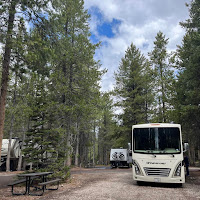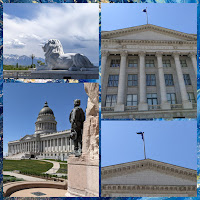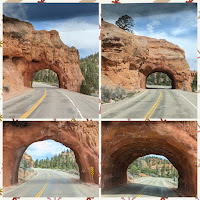After the Zion-Mount Carmel Tunnel and then heading up U.S. Highway 89 for forty-three miles, we turned east on Utah State Highway 12 and found ourselves in beautiful
Red Canyon of the Dixie National Forest.
We stopped at the Red Canyon Visitor’s Center, where we ate lunch and bought some souvenirs. Then we hiked the Pink Ledges Trail in a loop to and from the Visitor’s Center. This .5-mile trail was easy to moderate and took about 45 minutes. On the trail, we got a close look at the orange-red limestone and sandstone pinnacles, spires, columns, and hoodoos that make Red Canyon unique (a hoodoo is a rock formation that is shaped from expanding ice seeping into cracks of the rocks and creating structures that sometimes look like a person, animal, or other object; the name is derived from Hoodoo spirituality, in which certain natural forms are said to possess supernatural powers).
On the drive out of
Red Canyon, we drove through two amazing red-rock arch tunnels.
By late afternoon, we finally arrived at our destination:
Ruby’s Inn RV Park and Campground in Bryce Canyon City, Utah. At an elevation of 7,664 feet, we could feel right away that strenuous activity was going to make it a little harder to breathe. In addition to being at such a high elevation, we were back to freezing weather. In fact, the temperature dropped below freezing on our first two nights in Bryce Canyon City (the lows warmed up to the upper 30s for the remainder of our stay, with highs in the 60s).

Our RV site was dirt/gravel, had full hookups, and was a pull-through site. The site itself was not wider than normal but was longer than normal; long enough to fit two cars into! Our RV site did not have a grill, but it had a picnic table and a fire pit (in an odd location on the border with the neighboring RV site). We were shaded by gigantic pine trees. We had been advised when we checked into the campground that freezing temperatures were expected that night and that we shouldn’t hook up our hose to city water overnight. So, we used our freshwater tank for water. We did this for our first three nights at the campground to remain on the safe side.
On our first full day at Bryce Canyon, we visited our sixth national park since we started full-time RV travel:
Bryce Canyon National Park. The park features red rocks, pink cliffs, and the largest concentration of hoodoos found anywhere on earth. Founded in 1923, Bryce Canyon National Park was celebrating its 100th anniversary during our visit. It is a high-altitude park ranging from 8,000 to 9,000 feet in elevation, and the website warns that even mild exertion can lead to altitude sickness.
Similar to Zion National Park, there was a free shuttle bus that picked us up in Bryce Canyon City and took us to the
Visitor’s Center at Bryce Canyon National Park. There was a shuttle bus stop conveniently located at the entrance to Ruby’s Inn RV Park and Campground. This time, we didn’t have to exit the shuttle bus at the Visitor’s Center; instead, we could keep riding the same bus in a loop around the park, with stops at various places with trail heads and observation decks (riders must pay the entrance fee to the national park prior to boarding the shuttle bus or show a national park pass, which is what we have). We chose to exit the shuttle bus at the Visitor’s Center on this first trip, so we could get our passbooks stamped and buy some souvenirs.
Afterward, we got back on the shuttle bus and took it two stops to Bryce Point (elevation 8,300 feet). Bryce Point gave us beautiful views of
Bryce Canyon; in particular, what are called the Bryce Amphitheaters. From there, we decided to hike a portion of the Rim Trail, which runs approximately 5.5 miles and follows the Bryce Amphitheater portion of the park with a spectacular view of the park’s most popular area.
We walked less than .5 miles of the trail and returned to catch the shuttle bus to Inspiration Point.
Inspiration Point (elevation 8,100 feet) provides a bird’s-eye view of the world’s largest collection of hoodoos found within the Bryce Amphitheaters.
We could have hiked the Rim Trail to Inspiration Point from Bryce Point but chose to save our longest hike of the day for our next stop: Sunset Point.
Nowhere are the colors of Bryce Canyon's rock better displayed than from Sunset Point (elevation 8,000 feet). The unique rock you can see at Sunset Point is primarily composed of limestone deposited approximately 50 million years ago in a large freshwater lake. Iron oxide minerals supply the vibrant red, oranges, and yellows of the lower half of the cliffs.
From Sunset Point, we hiked about .5 miles along the Rim trail to Sunrise Point (elevation 8,015 feet).
From Sunrise Point, we caught the shuttle bus back to town and got off of the bus at
Ruby’s Inn General Store, where we bought a few grocery items. From
Ruby’s Inn, we took Ruby’s internal shuttle van back to the campground, where the van dropped us off close to our RV site.
Our second full day at Bryce Canyon became another maintenance day. The past two days we had been running the furnace more than usual because of the freezing temperatures.
[There is no short way to describe this, we tried.]
About two months ago, when we were in other freezing weather, we found that the furnace sometimes did not ignite the propone to provide warm air after the thermostat triggered that it should. This happened several times during our first two nights at Bryce Canyon, causing us to have to get up out of bed to lower the thermostat so the fans would go off; then wait a few minutes before raising the thermostat back up to a higher temperature to try to get the furnace to ignite the propane. Usually, this got the furnace running again, but if we weren’t vigilant, the temperature could drop to the low 60s in the RV before the cold air woke us up and we realized that the fans were running but the propane had not been ignited and the blower was not operating. So, we spent most of the day watching YouTube videos and trying to figure out what might be the issue. We came to believe that the problem was with the
“sail switch” as many of these videos explained that sometimes lint and other things get caught under the
“sail switch” and won’t allow it to move to indicate that there is sufficient air flow for the blower before igniting the propane. If the
“sail switch” doesn’t send the okay signal, it triggers the blower to shut off without the furnace igniting the propane.
[Really, this IS the condensed version. Ask Tim if you want to know more (everything) about RV furnaces.]
Based on what we watched, we believed that we could resolve the issue on our own by opening the external cover to the furnace and using a can of compressed air to clear any lint or other debris away from the
“sail switch”. The only problem was that we couldn’t get the external cover off of the furnace. We thought we might damage the cover if we pulled too hard, so we contacted Stephen, the technician who had fixed our bathroom door while we were at Zion. Stephen assured us that we were doing the right thing and needed to keep at it. Finally, we got the external cover off of the furnace (after discovering that someone had previously silicone glued the exhaust cover to the external cover on the RV).
We used the compressed air to clear the
“sail switch” and screwed the external cover back onto the furnace. Wow, we have certainly become handy!
But the furnace was not our only maintenance issue on this second full day at Bryce Canyon. As we tried to finally hook up our shorter freshwater hose to city water (the temperature was supposed to stay above freezing on this night), we discovered that we had a leak in the hose connection. We then tried to use our longer hose but couldn’t get it to connect properly to the RV without the use of an elbow that was on the shorter hose that had the leak, which we couldn’t get off of the shorter hose. By this time, it was evening and we decided to go to dinner instead and stay with the freshwater tank for water for another evening.
We took the internal Ruby’s shuttle van to one of three restaurants located at Ruby’s Inn called
Cowboy’s Buffet and Steak Room. This restaurant offers a buffet but also has a full-service menu if you prefer, which we did! We shared an appetizer of “cow chips” (potato slices smothered with melted cheese and topped with bacon bits); then Tim had the 8 oz tenderloin filet (with a baked potato and asparagus), while Pat had the Country Fried Steak (with mashed potatoes and asparagus). I guess we really love potatoes! The restaurant was quaint and included old photographs on the wall depicting the history of Ruby’s Inn. After dinner, we went to
Ruby’s Inn General Store to buy a new elbow for the longer freshwater hose so we could connect city water to the RV. We decided to walk back to the campground from
Ruby’s Inn (about a half-mile walk), since we hadn’t done much walking yet on that day.
On our third full day at Bryce Canyon, we had planned to take the shuttle bus to the national park for a longer hike, but the weather had other ideas for us. It was cloudy and rainy most of the day, and the temperatures stubbornly stayed in the 50s. Instead, Pat did some laundry and Tim caught up on paying bills, making lists, ancestry research, and writing blog entries. In the late afternoon, we installed the elbow on the longer hose and connected the hose to city water. No leaks! That evening, we had severe thunderstorms that knocked out the power for several hours. Since it was evening, we weren’t supposed to run our generator (although others did), so we had to rely on our house batteries keeping the furnace working to keep the RV warm while we slept. We lowered the temperature setting a bit, and the house batteries kept the furnace running until power was restored.
On our last full day at
Bryce Canyon, we had a small window of time to take the hike we wanted to take the previous day before rain was forecasted to start again. We took the free shuttle to the national park and got off at Sunset Point. From there, we hiked .6 miles downward on the Navajo Loop Trail, then 1.7 miles across and back up to Sunrise Point on the Queen’s Garden Trail. We started the hike at Sunset Point (elevation 8,000 feet), downward to an elevation of 7,362 feet, and then up again to Sunrise Point (elevation 8,015 feet). That’s an elevation change of 638 feet down and 653 feet up! The trail was dirt and wound around the canyon wall with sometimes not very wide paths. We stopped about halfway through the hike to eat the sandwiches we brought with us and had to take several more breaks on the way back up because of the altitude, but the hike was worth it! This is the most popular hike in
Bryce Canyon National Park because you get to hike down into the canyon to see the hoodoos and the Bryce Amphitheaters from the viewpoint at the bottom of the canyon and then from the viewpoint at the top of the canyon. The views are spectacular. We took many pictures that captured the beauty we observed on this hike, but we could never capture the experience in pictures!
Following our hike, we returned to
Ruby’s Inn RV Park and Campground just before the rain arrived. We spent the evening inside the RV, catching up on blog entries before going to bed to rest for our travels the next day.
The campground has 250 sites for RVs and tent campers under gigantic pine trees; some RV sites have full hookups and others have just water and electricity. RV sites are large pull-through sites with plenty of space to spread out in your site. The RV sites include a picnic table and fire pit, but no grills. The campground also has log cabins (these have electricity and beds, but no plumbing); and uniquely, the campground has tipis/teepees (these have no electricity, plumbing, or beds). Although the campground was mostly full during our visit, it was very peaceful. The only drawback for our RV site was that it was a longer walk from our RV site to the office and laundry facility than usually occurs at RV campgrounds (unless the internal shuttle van happened to come around when we were walking).
Ruby’s Inn RV Park and Campground is the closest campground to
Bryce Canyon National Park. There is a free shuttle bus that takes visitors to the national park, and one of the shuttle stops is located directly in front of the campground. In addition, Ruby’s has its own internal shuttle van that takes campers to the other establishments owned by Ruby’s, including Ruby’s Inn, a General Store, and three restaurants (Cowboy’s Buffet and Steak Room; Canyon Diner; and Ebenezer’s Barn and Grill (named after Ebenezer Bryce, a Mormon pioneer and the person for whom Bryce Canyon National Park was named), which features a live country band each evening).
Other amenities for
Ruby’s Inn RV Park and Campground include two restroom/shower facilities, a laundry facility, pool, hot tub, and fitness center. Uniquely, Ruby’s also offers a post office and an auto care center (they own a Sinclair gas station and other facilities across the street from Ruby’s Inn that offer gas, car and RV washing, and a convenience store). The campground also sells propane. Ruby’s Inn RV Park and Campground offers a wide variety of activities, including a rodeo; ATV tours; horseback trail rides; wagon rides; star gazing; an old western photo booth; bike and e-bike rentals; hiking; and a virtual reality ride called “Soaring Over Southern Utah.”
Despite our weather issues, we really enjoyed our stay at
Ruby’s Inn RV Park and Campground . We particularly liked that the restaurants and general store were within walking distance, and that there was a free shuttle bus to
Bryce Canyon National Park with a stop directly in front of the campground. We would definitely stay at Ruby’s again if we returned to this area in the future.





























































